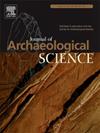Combining ATR far- and mid-infrared spectroscopy to distinguish native Australian plant exudates for cultural heritage analysis
IF 2.6
1区 地球科学
Q1 ANTHROPOLOGY
引用次数: 0
Abstract
Native Australian plant exudates are an important material for a variety of cultural uses including hafting materials and pigment binders. Spectroscopic analysis of exudates informs on their composition, properties, use and conservation status. However, native Australian exudates are not as well characterized as European species, although there are often chemical parallels between the two. While mid-IR has been demonstrated as an effective and standard method to distinguish some key exudate species, the fingerprint-region characterisation can become challenging for a particular group of exudates due to spectral similarities or overlaps, and therefore discrimination is not easily achievable. Therefore, the complementary data on molecular interactions observed in the far-IR region can provide additional means to characterize and discriminate between genera. In this study, samples from European artist materials and native Australian exudates were studied by both laboratory-based mid-IR and synchrotron based far-IR. Results from this work include establishing a novel non-destructive far-IR method for plant exudates such as resins, gums and kinos on the molecular level, as well as multivariate statistical analysis to differentiate at both the genera and species level. These outcomes identify an innovative approach to understanding these complex molecular chemistries of plant exudates as well as a method to characterize resins, kinos and gums in important archaeological and cultural heritage materials in Australia and worldwide.
结合ATR远、中红外光谱技术鉴别澳大利亚本土植物分泌物,用于文化遗产分析
澳大利亚本土植物的分泌物是多种文化用途的重要材料,包括草帽材料和颜料粘合剂。通过对渗出液的光谱分析,可以了解渗出液的成分、性质、用途和保存状况。然而,澳大利亚本土的分泌物并不像欧洲物种那样具有很好的特征,尽管两者之间经常有化学上的相似之处。虽然中红外已被证明是一种有效和标准的方法来区分一些关键的渗出物物种,但由于光谱相似或重叠,指纹区域表征对于特定组的渗出物可能变得具有挑战性,因此不容易实现区分。因此,在远红外区观察到的分子相互作用的补充数据可以提供表征和区分属的额外手段。在这项研究中,来自欧洲艺术家材料和澳大利亚本土渗出物的样品通过实验室中红外和同步加速器远红外进行了研究。本文的研究成果包括建立了一种在分子水平上对树脂、树胶和基诺等植物渗出物进行无损远红外分析的新方法,以及在属和种水平上进行多元统计分析的方法。这些结果确定了一种创新的方法来理解这些植物渗出物的复杂分子化学,以及一种方法来表征树脂,基诺和树胶在重要的考古和文化遗产材料在澳大利亚和世界各地。
本文章由计算机程序翻译,如有差异,请以英文原文为准。
求助全文
约1分钟内获得全文
求助全文
来源期刊

Journal of Archaeological Science
地学-地球科学综合
CiteScore
6.10
自引率
7.10%
发文量
112
审稿时长
49 days
期刊介绍:
The Journal of Archaeological Science is aimed at archaeologists and scientists with particular interests in advancing the development and application of scientific techniques and methodologies to all areas of archaeology. This established monthly journal publishes focus articles, original research papers and major review articles, of wide archaeological significance. The journal provides an international forum for archaeologists and scientists from widely different scientific backgrounds who share a common interest in developing and applying scientific methods to inform major debates through improving the quality and reliability of scientific information derived from archaeological research.
 求助内容:
求助内容: 应助结果提醒方式:
应助结果提醒方式:


